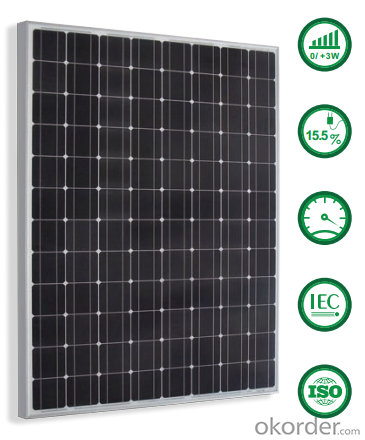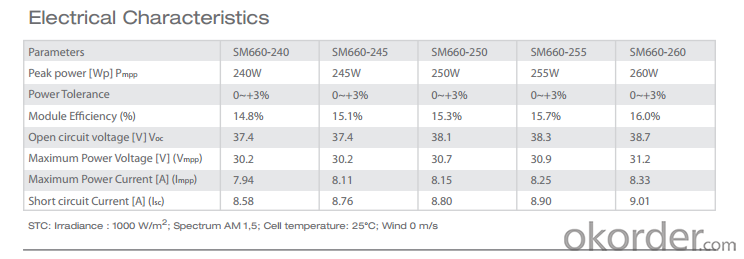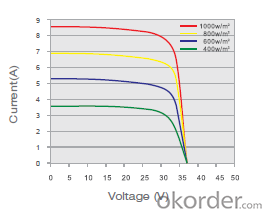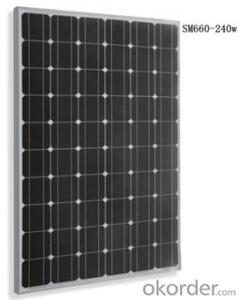Monocrystalline Solar Module SM660-250W with Sun Tracking Solar Panels
- Loading Port:
- Shanghai
- Payment Terms:
- TT OR LC
- Min Order Qty:
- 1 set
- Supply Capability:
- 80000 set/month
OKorder Service Pledge
OKorder Financial Service
You Might Also Like
Product Description:
1.Structure of Monocrystalline Solar Module SM660 250W Series Description:
Monocrystalline Solar Module SM660 250W: High efficiency crystalline solar cell. Even if under the weak light, the solar module can produce maximum power output.
II Tempered glass (toughened glass): Anti-reflecting coating and high transmission rate glass increase the power output and mechanical strength of solar module.
III EVA and TPT: Using high quality EVA and TPT to prevent destroying and water.
IV AI frame: Without screw, rner connection. 6 holes on the frame can be installed easily.
V Junction box: Multi function junction box with water proof.
VI Long lifetime: ≥25 years; Less power decrease.
VII Good performance of preventing from atrocious weather such as wind and hails.
VIII Resisting moisture and etching effectively, not effected by geology.
IX The certificate issued by international authority: TUV, IEC, CE.ISO9001.MCS
2. Characteristics of Monocrystalline Silicon Solar Panel:
• Guaranteed tolerance +3%
• High manufacture standards
• Reliable power output
• High module efficiency
• Module efficiency up to 15.5%
• Cells efficiency up to 17.6%
• Strong compressive strength
• Certified to withstand high wind of 2400Pa
3. Standard Test Conditions of Monocrystalline Silicon Solar Panel:
The opto-electrical specifications shown below are stabilized values being measured at Standard Test Conditions, Irradiance: 1000W/m2, Spectrum: AM1.5 at 25°C, The info below is subject to manufacturing tolerances. Where appropriate minutes of measurement are available and are used for the dimensioning of the installation.
Advantages of Polycrystalline Silicon Solar Panel
• 25 year transferrable power output warranty: 10 years / 90%, 25 years / 80%*
• 12 year material and workmanship warranty
• Timeliness of delivery
• Quality Products certified (TUV, IEC, CE.ISO9001.MCS)
4. Solar Panel Images



5. Monocrystalline Silicon Solar Panel Specification




6.FAQ
We have organized several common questions for our clients,may help you sincerely:
①How about your company?
We are a private-owned high-tech company who specializes in developing, manufacturing and marketing of silicon ingots, solar wafer, solar cells, solar modules, PV systems and solar applications products.
At present, We has one research & development team, whose members are well-known experts in photovoltaic area. We also have advanced production and test equipment.
②How to guarantee the quality of the products?
Our products have been certified by CE, CEC,MCS, IEC61215, IEC61730 and ISO9001.
• 25 year transferrable power output warranty: 10 years / 90%, 25 years / 80%*
• 12 year material and workmanship warranty
• Timeliness of delivery
• Quality Products certified (TUV, IEC, CE.ISO9001.MCS)
③How long can we receive the product after purchase?
In the purchase of product within three working days, We will arrange the factory delivery as soon as possible. The pecific time of receiving is related to the state and position of customers.Commonly 7 to 10 working days can be served.
- Q: I am confused. I am planning to build a simple 2Watt solar system to power some lights in my house. . I wonder if it is possible to power up a 2Watt bulb using 2Watt solar power?2. Normally, when we are reading the power rating of a bulb, we will read the wattage, so what about the voltage and current rating?3. If the current is insufficient, will the bulb light up?I am having a solar panel that can output 2W power but I am not sure about the output voltage, how can I find out about the current? I am getting really confused.
- Hey, okorder
- Q: this solar panel i saw was for 500 dollars(i get a 25% discount)and i was curious will they produce electricity? or just heat?what do they do?is it a good investment?here is a link to the one i would like, no reviews but it looks new to the site.
- You need a plan as to what you are going to with 80 watts of power. 80w at the best, it will usually be less. One problem I have is the limited specs, you don't even know the voltage. And you get a Sharp Module but nothing else is mentioned about it. I wouldn't buy it unless you can get full specs on it and on the Sharp Module. With no specs, it's difficult to get a refund if it is defective. If you are going to store it and use it for an AC appliance, a small one, you will need: a charge controller (to control the charge into the battery) a lead acid battery (to store energy for when the sun is out) an inverter (to convert 2 volts DC into 20 VAC) and all of these cost. .
- Q: what is one benifit in a solar panel?
- In the UK, the only real benefit comes from the subsidies given to owners of solar panels. I believe the same is true elsewhere in the world. I suppose smugness might be a benefit though it is not justified.
- Q: Why can not the solar panel load directly?
- Power supply must be a number of individual battery strings, connected in parallel and tightly packaged into components.
- Q: How much space do I need for solar panels?
- The amount of space needed for solar panels varies depending on the size and capacity of the panels. On average, a typical residential solar panel system requires about 100-400 square feet of roof space, but it can also be installed in a backyard or ground-mounted depending on available space. It is best to consult with a solar installation professional who can assess your specific needs and determine the exact space requirements for your solar panels.
- Q: What is the impact of dust and dirt on solar panels' efficiency?
- Dust and dirt on solar panels can significantly reduce their efficiency. When dust accumulates on the surface of the panels, it blocks sunlight from reaching the photovoltaic cells, thereby reducing the amount of electricity generated. The accumulation of dirt can create a barrier that hinders the panels' ability to absorb sunlight effectively. Regular cleaning and maintenance of solar panels are crucial to ensure optimal efficiency and maximize energy production.
- Q: Are there any safety precautions to consider when installing solar panels?
- Yes, there are several safety precautions to consider when installing solar panels. Firstly, it is important to work with a qualified and experienced installer who follows industry standards and guidelines. Adequate training and knowledge of electrical systems are crucial to ensure safe installation. Additionally, proper precautions should be taken when working with heights, as solar panels are typically installed on rooftops. This includes using appropriate fall protection equipment and following all relevant safety protocols. It is also essential to turn off electricity before starting the installation process to avoid electrical shocks. Finally, regular maintenance and inspections should be conducted to ensure the panels are in good condition and operating safely.
- Q: Can solar panels be used for powering electric boats or marine vessels?
- Yes, solar panels can be used to power electric boats or marine vessels. Solar panels convert sunlight into electricity, which can then be used to charge the batteries of electric boats or directly power their electric motors. This sustainable and renewable energy source offers a clean and environmentally friendly alternative to traditional fossil fuel-powered propulsion systems for marine transportation.
- Q: I need to know where I can buy the parts or find them as scrap to make my own solar panels. Is there a cheap way of buying the panels or can I make them myself.
- Build okorder
Send your message to us
Monocrystalline Solar Module SM660-250W with Sun Tracking Solar Panels
- Loading Port:
- Shanghai
- Payment Terms:
- TT OR LC
- Min Order Qty:
- 1 set
- Supply Capability:
- 80000 set/month
OKorder Service Pledge
OKorder Financial Service
Similar products
Hot products
Hot Searches
Related keywords






























